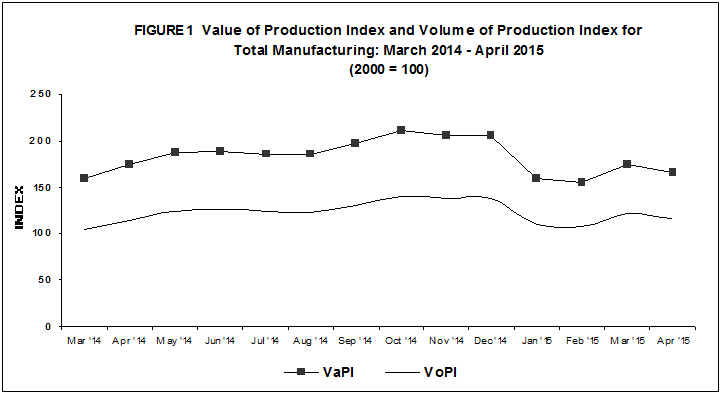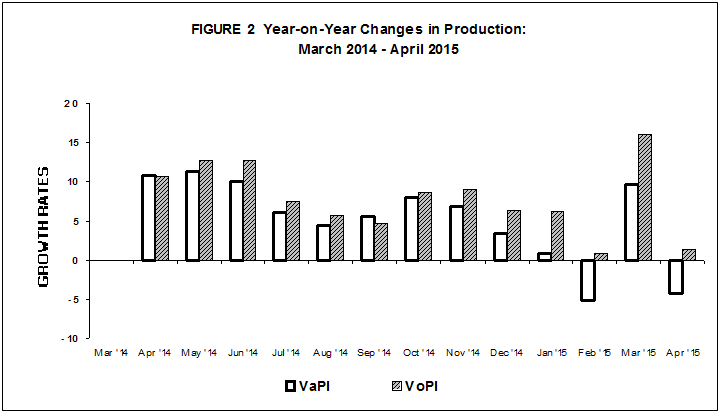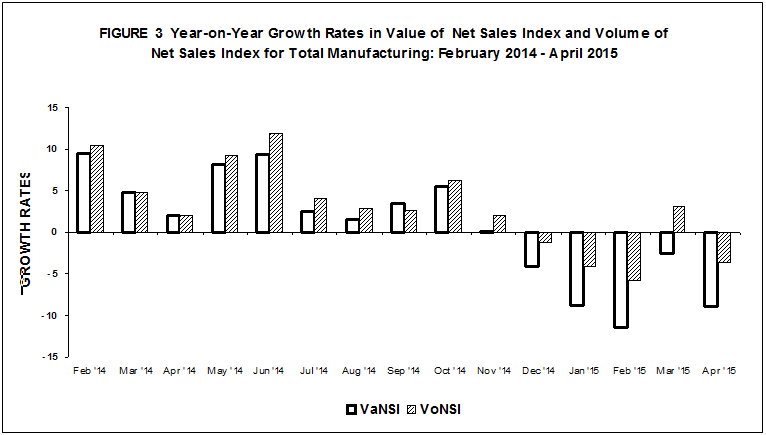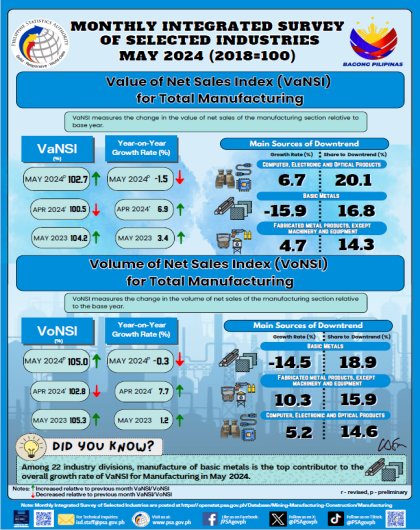|
Table A Year-on-Year Growth Rates for Production Index, Net Sales Index
and Producer Price Index: April 2015 and April 2014
|
||
|---|---|---|
|
TOTAL MANUFACTURING |
April
2015
|
April
2014
|
|
YEAR-ON-YEAR GROWTH |
|
|
|
Production Index (2000=100) |
|
|
|
Value (VaPI) |
-4.2 |
10.9 |
|
Volume (VoPI) |
1.4 |
10.8 |
|
Net Sales Index (2000=100) |
|
|
|
Value (VaNSI) |
-8.9 |
2.1 |
|
Volume (VoNSI) |
-3.6 |
2.1 |
|
Producer Price Index (2000=100)
|
-5.4r
|
0.0
|
- Value of Production Index slides in April 2015
Value of Production Index (VaPI) for total manufacturing exhibited an annual drop of 4.2 percent in April 2015 compared with the two-digit growth of 10.9 percent during the same month last year, according to the preliminary results of the Monthly Integrated Survey of Selected Industries (MISSI). This was primarily due to the slump in production values observed in eight major sectors that offset the growth reported by 12 major sectors. The heavily weighted sector of petroleum products influenced the largest decrease with 34.6 percent. Other sectors that reported two-digit decreases were miscellaneous manufactures (-20.7%), food manufacturing (-12.1%) and wood and wood products (-12.1%). Refer to Tables 1-A and 1.
- Volume of Production Index keeps positive rate in April 2015
Volume of Production Index (VoPI) maintained a positive growth rate registering at 1.4 percent in April 2015. The growth was mainly due to the output performance of 13 major sectors, with significant increases noted in ten sectors namely: chemical products (46.2%), tobacco products (35.5%), furniture and fixtures (22.8%), basic metals (22.3%), textiles (17.8%), printing (14.7%), machinery except electrical (14.5%), paper and paper products (13.3%), leather products (11.7%), and beverages (10.2%). Refer to Tables 1-B and 2.


- Value of Net Sales Index decelerates in April 2015
Value of Net Sales Index (VaNSI) declined at the rate of 8.9 percent in April 2015 compared with 2.1 percent increase during the same month of last year. This decrease was mainly due to the reduction in VaNSI observed in the following major sectors: printing (-40.8%), petroleum products (-26.9%), electrical machinery (-20.6%), and fabricated metal products (-10.8%). Refer to Tables 2-A and 3.
- Volume of Net Sales Index also declines in April 2015
Volume of Net Sales Index (VoNSI) slightly slipped by 3.6 percent in April 2015. There were seven major sectors that showed decreases in VoNSI, with two sectors significantly pulling down VoNSI. These were printing (-40.3%), and electrical machinery (-14.4%). Refer to Tables 2-B and 4.

- Average Capacity Utilization in April 2015 is 83.2 percent
Average capacity utilization in April 2015 for total manufacturing was recorded at 83.2 percent. Fifty percent or 10 of the 20 major industries operated at 80 percent and above capacity utilization rates. These are:
- basic metals (88.8%)
- petroleum products (88.3%)
- non-metallic mineral products (86.2%)
- machinery except electrical (84.7%)
- electrical machinery (84.4%)
- food manufacturing (84.2%)
- chemical products (83.2%)
- paper and paper products (83.1%)
- rubber and plastic products (82.5%)
- wood and wood products (80.8%)
The proportion of establishments that operated at full capacity (90% to 100%) was 26.4 percent in April 2015. About 55.3 percent of the establishments operated at 70% to 89% capacity while 18.3 percent of the establishments operated below 70% capacity. Refer to Table 6 and B.
|
Table B Distribution of Key Manufacturing Establishments by Capacity Utilization for Total Manufacturing: March 2015 |
|
|---|---|
|
Capacity Utilization |
Percent Share |
|
Below 50% |
3.6 |
|
50% - 59% |
4.3 |
|
60% - 69% |
10.4 |
|
70% - 79% |
22.0 |
|
80% - 89% |
33.3 |
|
90% - 100% |
26.4 |
- Industry Coverage
The 2015 MISSI utilizes the 2009 Philippine Standard Industrial Classification (PSIC) to classify major industries and sub-industries. Twenty major industries of the 2009 PSIC were formed to comprise the industry coverage of the 2015 MISSI. These are presented in the table below.
|
2009 PSIC CODE |
INDUSTRY DESCRIPTION |
|---|---|
|
C10 |
Food manufacturing * |
|
C11 |
Beverages |
|
C12 |
Tobacco products |
|
C13 |
Textiles* |
|
C14, C152 |
Footwear and wearing apparel |
|
C151 |
Leather products |
|
C16 |
Wood and wood products* |
|
C17 |
Paper and paper products |
|
C18 |
Printing |
|
C19 |
Petroleum products* |
|
C20,C21 |
Chemical products* |
|
C22 |
Rubber and plastic products* |
|
C23 |
Non-metallic mineral products* |
|
C24 |
Basic metals* |
|
C25,C3311 |
Fabricated metal products |
|
C262,C275,C28, C263,C268,C3312,C332 |
Machinery except electrical* |
|
C261,C264,C27, C29301,C3314,C332 |
Electrical machinery* |
|
C29 except C29301, C30,C3315 |
Transport equipment |
|
C31 |
Furniture and fixtures |
|
C265,C266,C267,C32, C3313,C3319 |
Miscellaneous manufactures |
|
Note: * - Major industries categorized into sub-industries |
|
- Response Rate
The response rates for the April 2015 MISSI and PPS are 79.8 percent and 87.3 percent, respectively. Refer to Tables 7 and 8.
|
Table C Response Rates For Total Manufacturing
(In percent)
|
||
|---|---|---|
|
|
April 2015 |
March 2015
(Revised)
|
|
MISSI |
79.8 |
91.0r |
|
PPS |
87.3 |
93.3r |
r -revised
Data of non-responding samples were estimated using short-term geometric mean of the relative values of responding samples within the industry class. Revisions to the preliminary estimates are done upon receipt of actual reports of late respondents.
|
Gainers |
Year-on-Year Growth (%) |
|
|---|---|---|
|
April 2015
|
March 2015
(revised)
|
|
|
Chemical products |
16.7 |
35.3 |
|
Tobacco products |
45.2 |
39.0 |
|
Beverages |
17.9 |
23.2 |
|
Basic metals |
15.5 |
68.0 |
|
Machinery except electrical |
6.5 |
-7.7 |
|
Textiles |
15.3 |
25.0 |
|
Paper and paper products |
13.5 |
4.3 |
|
Rubber and plastic products |
6.8 |
16.8 |
|
Printing |
13.7 |
26.8 |
|
Non-metallic mineral products |
3.3 |
1.7 |
|
Footwear and wearing apparel |
2.1 |
-20.3 |
|
Leather products |
11.7 |
11.3 |
|
Losers |
Year-on-Year Growth (%) |
|
|---|---|---|
|
April 2015
|
March 2015
(revised)
|
|
|
Petroleum products |
-34.6 |
60.2 |
|
Food manufacturing |
-12.1 |
-6.9 |
|
Electrical machinery |
-9.5 |
-4.2 |
|
Miscellaneous manufactures |
-20.7 |
-2.8 |
|
Fabricated metal products |
-6.9 |
-5.7 |
|
Wood and wood products |
-12.1 |
-20.7 |
|
Transport equipment |
-1.3 |
0.0 |
|
Furniture and fixtures |
-3.6 |
-19.3 |
|
Gainers |
Year-on-Year Growth (%) |
|
|---|---|---|
|
April 2015
|
March 2015
(revised)
|
|
|
Chemical products |
46.2 |
71.1 |
|
Machinery except electrical |
14.5 |
-7.0 |
|
Basic metals |
22.3 |
79.9 |
|
Tobacco products |
35.5 |
29.8 |
|
Beverages |
10.2 |
15.2 |
|
Textiles |
17.8 |
27.4 |
|
Non-metallic mineral products |
9.2 |
8.3 |
|
Paper and paper products |
13.3 |
4.4 |
|
Furniture and fixtures |
22.8 |
9.3 |
|
Printing |
14.7 |
27.9 |
|
Rubber and plastic products |
4.8 |
13.7 |
|
Leather products |
11.7 |
11.2 |
|
Footwear and wearing apparel |
3.3 |
-19.2 |
|
Losers |
Year-on-Year Growth (%) |
|
|---|---|---|
|
April 2015
|
March 2015
(revised)
|
|
|
Food manufacturing |
-13.9 |
-8.6 |
|
Petroleum products |
-18.6 |
96.1 |
|
Electrical machinery |
-2.4 |
4.8 |
|
Miscellaneous manufactures |
-15.1 |
0.1 |
|
Fabricated metal products |
-3.2 |
-2.6 |
|
Transport equipment |
-0.1 |
2.1 |
|
Wood and wood products |
-0.7 |
-12.3 |
|
Gainers |
Year-on-Year Growth (%) |
|
|---|---|---|
|
April 2015
|
March 2015
(revised)
|
|
|
Basic metals |
6.9 |
50.1 |
|
Tobacco products |
13.7 |
32.6 |
|
Footwear and wearing apparel |
7.4 |
-17.8 |
|
Beverages |
3.7 |
6.5 |
|
Machinery except electrical |
1.5 |
8.2 |
|
Rubber and plastic products |
11.8 |
8.9 |
|
Non-metallic mineral products |
3.8 |
4.9 |
|
Textiles |
5.6 |
2.4 |
|
Paper and paper products |
4.3 |
1.7 |
|
Miscellaneous manufactures |
3.8 |
5.3 |
|
Furniture and fixtures |
9.9 |
0.8 |
|
Leather products |
29.6 |
40.0 |
|
Wood and wood products |
7.1 |
-1.6 |
|
Losers |
Year-on-Year Growth (%) |
|
|---|---|---|
|
April 2015
|
March 2015
(revised)
|
|
|
Electrical machinery |
-20.6 |
-17.8 |
|
Petroleum products |
-26.9 |
-24.2 |
|
Chemical products |
-7.1 |
6.5 |
|
Printing |
-40.8 |
-26.0 |
|
Food manufacturing |
-2.6 |
0.5 |
|
Transport equipment |
-8.2 |
4.8 |
|
Fabricated metal products |
-10.8 |
-3.0 |
|
Gainers |
Year-on-Year Growth (%) |
|
|---|---|---|
|
April 2015
|
March 2015
(revised)
|
|
|
Chemical products |
16.4 |
34.7 |
|
Machinery except electrical |
9.2 |
9.0 |
|
Basic metals |
13.2 |
60.7 |
|
Furniture and fixtures |
40.0 |
36.6 |
|
Non-metallic mineral products |
9.7 |
11.7 |
|
Footwear and wearing apparel |
8.7 |
-16.7 |
|
Miscellaneous manufactures |
11.1 |
8.5 |
|
Textiles |
7.9 |
4.4 |
|
Tobacco products |
6.1 |
23.8 |
|
Rubber and plastic products |
9.8 |
6.0 |
|
Wood and wood products |
21.0 |
8.9 |
|
Paper and paper products |
4.1 |
1.8 |
|
Leather products |
29.7 |
39.9 |
|
Losers |
Year-on-Year Growth (%) |
|
|---|---|---|
|
April 2015
|
March 2015
(revised)
|
|
|
Electrical machinery |
-14.4 |
-10.0 |
|
Petroleum products |
-8.9 |
-7.2 |
|
Food manufacturing |
-4.6 |
-1.4 |
|
Printing |
-40.3 |
-25.3 |
|
Transport equipment |
-7.1 |
7.0 |
|
Beverages |
-3.1 |
-0.4 |
|
Fabricated metal products |
-7.4 |
0.1 |

